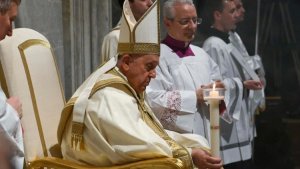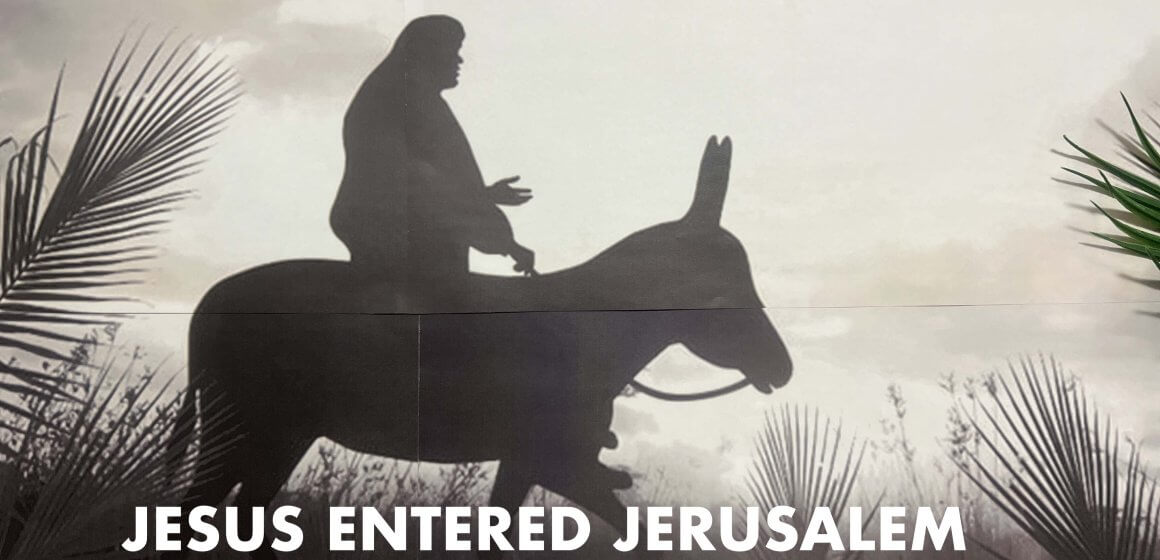|
LISTEN TO THIS THE AFRICANA VOICE ARTICLE NOW
Getting your Trinity Audio player ready...
|
Easter, Passover, and Ramadan are important religious holidays celebrated by Christians, Jews, and Muslims. Each holiday holds deep spiritual significance for its followers, and they are an opportunity for people of these faiths to come together and celebrate their beliefs.
CHRISTIANITY
Easter
Easter, the Christian holiday, is celebrated on the first Sunday following the first full moon after the vernal equinox, which falls between March 21st and April 25th.
Easter commemorates the resurrection of Jesus Christ from the dead, as described in the New Testament. For Christians, the resurrection represents the triumph of life over death and the hope of eternal life for believers.
Easter is also a time of renewal and new beginnings, as it marks the end of Lent, a period of reflection and self-denial. Easter is celebrated with church services, feasting, and the exchange of gifts.
The Pope and Easter Vigil

The Pope, the Roman Catholic church leader, is perhaps one the most recognized Christian figure who celebrates Easter.
As the leader of the Catholic Church, the Pope typically presides over several Easter ceremonies in Rome and around the world.
One of the most important events is the Easter Vigil, which occurs on Holy Saturday, the day before Easter Sunday. The Pope presides over this solemn service, which includes the Paschal candle’s lighting, the Easter water’s blessing, and the Eucharist’s celebration.
On Easter Sunday, the Pope delivers a special message from the balcony of St. Peter’s Basilica to the crowds gathered in St. Peter’s Square. This message, known as the Urbi et Orbi blessing, is a message of hope and peace for the world.
The Pope also celebrates Mass in St. Peter’s Square, usually attended by thousands of pilgrims worldwide.
Easter characters
Easter begins with Jesus’ arrival in Jerusalem on what is now known as Palm Sunday, where he was greeted as a savior by the crowds of people who laid palm branches and their cloaks on the ground for him to ride his donkey over.
However, Jesus’ teachings threatened the political and religious authorities, and he was soon arrested by the Roman authorities, with the assistance of the Jewish high priests.
Jesus was then subjected to a series of trials before being sentenced to death by crucifixion.
Pontius Pilate
Pontius Pilate was the Roman governor who presided over Jesus’ trial and sentenced him to death. Despite finding no fault in Jesus, Pilate was pressured by the Jewish high priests to sentence Jesus to death.
Pontius Pilate is famously known for “washing his hands” in a symbolic gesture to indicate his lack of responsibility for the crucifixion of Jesus Christ.
The story appears in the Gospel of Matthew, where it is stated that Pilate publicly declared his innocence of Jesus’ blood and then washed his hands before the crowd, saying, “I am innocent of this man’s blood. It is your responsibility” (Matthew 27:24).
The phrase “washing his hands” has become a widely used metaphor for someone who tries to distance themselves from a situation or avoid taking responsibility for their actions.
High Priests and Revolutionaries
Caiaphas and Annas were the Jewish high priests involved in sentencing Jesus to death. They saw Jesus as a threat to their religious authority and worked to have him executed.
Barabbas was a criminal who was imprisoned at the time of Jesus’ trial. According to the Gospels, Pilate offered to release one prisoner as a goodwill gesture for the Passover holiday, and the crowd chose Barabbas to be released instead of Jesus.
At the time of Jesus’ crucifixion, two other criminals were also crucified alongside him, one on either side. They are known as the “two thieves” or “two revolutionaries” in the Christian tradition.
The main character in the Easter story, of course, is Jesus himself, who is seen as the Son of God by Christians. The story of his death and resurrection is a central tenet of the Christian faith, symbolizing the triumph of life over death and the promise of eternal life for believers.
What about the Easter Bunny?
The Easter Bunny is seen as an inclusive way to mark the Easter Holiday season, especially for families with children.
The Easter Bunny is a popular symbol of Easter in many parts of the world, particularly in Western cultures. The origins of the Easter Bunny are somewhat obscure, but the bunny is often associated with the Germanic goddess Eostre or Ostara, who was celebrated during the spring equinox. Eostre was often depicted with a hare, which was seen as a symbol of fertility and new life.
The tradition of the Easter Bunny may also have roots in medieval Europe, where rabbits and hares were often associated with the Virgin Mary. In some cultures, the hare was believed to be able to reproduce without a mate, which was seen as a miraculous feat that was similar to the Virgin Mary’s conception of Jesus.
The modern concept of the Easter Bunny as a gift-giving character may have originated in Germany in the 17th century. German immigrants brought the tradition to America, where it became a popular part of Easter celebrations.
Today, the Easter Bunny is often depicted as a friendly, anthropomorphic rabbit who brings Easter eggs and treats to children. While the origins of the Easter Bunny are somewhat obscure, the tradition of the bunny is a beloved part of Easter celebrations in many parts of the world, particularly for children.
ISLAM
Ramadan,
The Muslim holiday is a month-long fasting, prayer, and reflection period. It is based on the lunar calendar, and the exact date of the start of Ramadan can vary each year.
As of 2021, the estimated global population of Muslims is approximately 1.9 billion people, which makes Islam the second-largest religion in the world after Christianity.
However, it’s difficult to estimate precisely how many Muslims observe Ramadan, as the level of observance can vary widely depending on factors such as location, culture, and personal beliefs.
It’s estimated that between 80 to 90 percent of the world’s Muslims observe Ramadan in some capacity, whether by fasting, prayer, or other acts of worship.
Muslims fast from dawn until sunset this month, abstaining from food, drink, smoking, and other physical needs. The purpose of the fast is to purify the body and the soul and to strengthen one’s relationship with Allah.
It is also a time for Muslims to reflect on their faith, seek forgiveness for their sins, and practice charity towards others. Ramadan culminates in the celebration of Eid al-Fitr, a festival that marks the end of the fast and is celebrated with prayers, feasting, and the exchange of gifts.
When was Ramadan first celebrated?
The first celebration of Ramadan took place in the year 624 CE after the Prophet Muhammad received the first revelation of the Quran.
According to Islamic tradition, during the month of Ramadan, the Angel Gabriel revealed the first verses of the Quran to the Prophet Muhammad. Since then, Muslims worldwide have observed Ramadan as a time of spiritual reflection, self-discipline, and worship.
The celebration of Eid al-Fitr
Eid al-Fitr is a major holiday celebrated by Muslims all around the world. It marks the end of the month-long fasting period of Ramadan, during which Muslims fast from dawn until sunset. The celebration of Eid al-Fitr typically lasts for three days, although the exact length of the holiday can vary depending on cultural and regional traditions.
During Eid al-Fitr, Muslims gather with family and friends to celebrate the end of Ramadan and thank Allah for the month’s blessings. The day usually begins with a special prayer in large congregations in mosques or open areas such as parks or fields. An imam usually leads the prayer, followed by a sermon emphasizing the importance of unity, compassion, and charity.
After the prayer, Muslims often visit the graves of loved ones, distribute food and gifts to the poor, and engage in acts of charity and community service. They also wear new clothes and decorate their homes with lights and other festive decorations.
Food is a central part of the Eid al-Fitr celebration, and many traditional dishes are prepared for the occasion. Families and friends gather for meals and feasts, and it is common to exchange sweets and other treats as gifts.
[vertical_lokkna_ads]
JUDAISM
Passover
Passover, the Jewish holiday, is a seven-day festival commemorating the Israelites’ liberation from slavery in ancient Egypt.
According to the book of Exodus, God commanded the Israelites to mark their doors with the blood of a sacrificial lamb so that the Angel of Death would “pass over” their homes during the final plague.
The Israelites then fled Egypt, and Passover celebrates their journey to freedom.
The holiday is marked by the Seder, a festive meal that retells the story of the Exodus, and the eating of unleavened bread, which symbolizes the Israelites’ hasty departure from Egypt.
When was Passover first celebrated?
Passover, also known as Pesach, is one of the oldest Jewish holidays and has been celebrated for over 3,000 years. The first Passover was celebrated in ancient Egypt, according to the Jewish biblical account, when the Israelites were enslaved and oppressed by the Pharaoh.
The story goes that God sent Moses to demand the release of the Israelites, and when the Pharaoh refused, God inflicted ten plagues on Egypt. The final plague was the death of every firstborn in the land, but the Israelites were instructed to mark their doors with the blood of a sacrificial lamb so that the Angel of Death would “pass over” their homes.
This event led to the Israelites’ liberation from slavery and the establishment of their identity as a people. Passover has been celebrated annually ever since as a way of commemorating this historical event and passing down the story to future generations.
Who was Pharaoh, the Ruler of Egypt, During Passover?
Although the Pharaoh remains unnamed in the biblical text, there have been various attempts to identify him based on historical evidence and archaeological findings.
Some scholars have suggested that the Pharaoh during the Exodus was Ramses II, who ruled Egypt in the 13th century BCE. Others have suggested that the Pharaoh may have been one of Ramses II’s predecessors, such as Seti I or Amenhotep III.
However, there is no definitive evidence to support any of these theories, and the Pharaoh’s identity during the Passover remains a subject of debate among scholars.
How Orthodox Jews Celebrate Passover
Orthodox Jews celebrate Passover, also known as Pesach, following traditional Jewish law and customs. The celebration begins on the evening of the 14th day of the Jewish month of Nissan and lasts seven or eight days, depending on location and tradition.
Before the holiday begins, Orthodox Jews thoroughly clean their homes, removing all leavened products (known as chametz) and replacing them with unleavened products (known as matzah), remembering the hurried departure from Egypt when the Israelites did not have time to allow their bread to rise.
The first two nights of Passover are marked by the Seder, a festive meal that retells the story of the Exodus from Egypt. The Seder includes the reading of the Haggadah, a text that recounts the story of the Israelites’ liberation from slavery and the eating of symbolic foods such as matzah and bitter herbs. The Seder is a time for family and friends to come together and celebrate the holiday.
During the week of Passover, Orthodox Jews refrain from eating leavened products and instead eat matzah, which symbolizes the haste of the Israelites’ departure from Egypt. There are also specific Passover food restrictions, and many traditional Passover foods are eaten, such as gefilte fish, matzah ball soup, and brisket.
The holiday of Passover also involves special prayers, readings, and songs recited throughout the week. Orthodox Jews also visit synagogues for daily services and participate in other religious activities to mark the holiday.
What about other Religions, Hindus, Buddhists, and Sikhs?
Hinduism:
- Diwali: This is one of the most important festivals in Hinduism, also known as the Festival of Lights. It symbolizes the victory of good over evil and is celebrated with lights, fireworks, and the exchange of sweets and gifts. It usually takes place in October or November.
- Holi: This is a colorful and joyous festival that marks the arrival of spring. It usually takes place in February or March. It is celebrated by throwing colored powder and water on each other, and it is a time for people to come together and celebrate the joy of life.
- Navratri: This nine-day festival honors the goddess Durga and celebrates feminine power and strength. It is celebrated with dancing, music, and the exchange of gifts. It usually takes place in September or October.
Buddhism:
- Vesak: This is the most important festival in Buddhism, also known as Buddha Day. It commemorates the birth, enlightenment, and death of the Buddha, and it is a time for reflection, meditation, and the giving of alms. It usually takes place in May or June.
- Asalha Puja: This festival commemorates the Buddha’s first sermon, which he gave to his disciples after attaining enlightenment. It is a time for studying the Buddha’s teachings and reflecting on their meaning in our lives. It usually takes place in July.
- Kathina: This is a festival of giving that celebrates the end of the rainy season and the generosity of the Buddhist community. It is a time for offering gifts to the Sangha, or a community of monks, and for strengthening the bonds of friendship and community. It usually takes place in October or November.
Sikhism:
- Vaisakhi: This is the most important festival in Sikhism, commemorating the creation of the Khalsa, a community of baptized Sikhs, by Guru Gobind Singh. It is celebrated with music, dancing, and the exchange of gifts, and it is a time for reaffirming the principles of Sikhism. It usually takes place in April.
- Guru Nanak’s Birthday: This festival celebrates the birth of Guru Nanak, the founder of Sikhism. It is a time for studying his teachings, performing acts of service and charity, and coming together as a community. It usually takes place in November.
- Diwali: Although Diwali is primarily a Hindu festival, it is also celebrated by Sikhs as Bandi Chhor Divas, which means “Prisoner Release Day.” It commemorates the release of Guru Hargobind, the sixth Sikh guru, from imprisonment by the Mughal emperor Jahangir. It is celebrated with lights, fireworks, and the exchange of sweets and gifts. It usually takes place in October or November.

















































LEAVE A COMMENT
You must be logged in to post a comment.